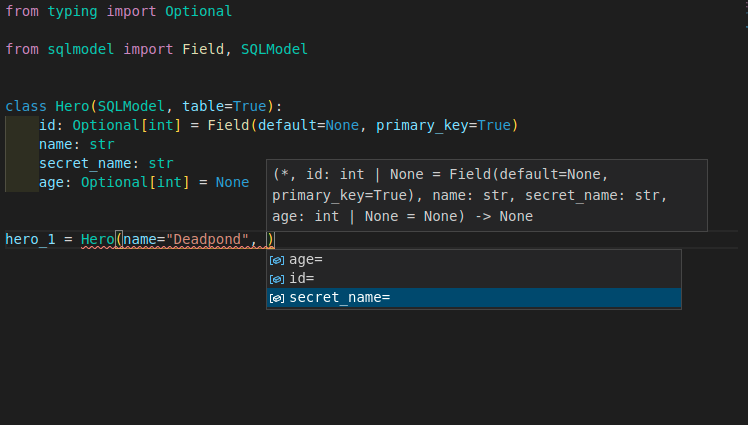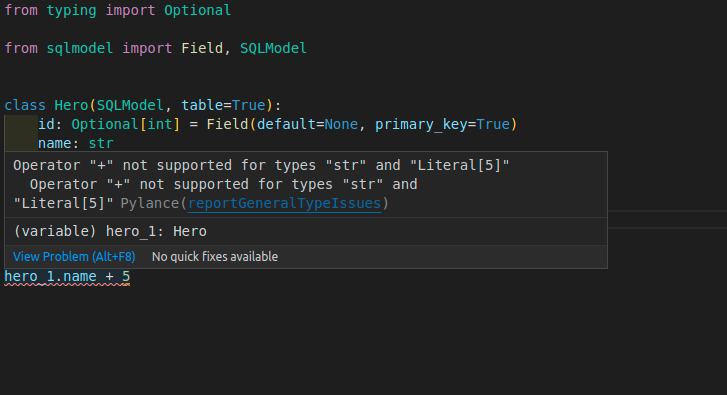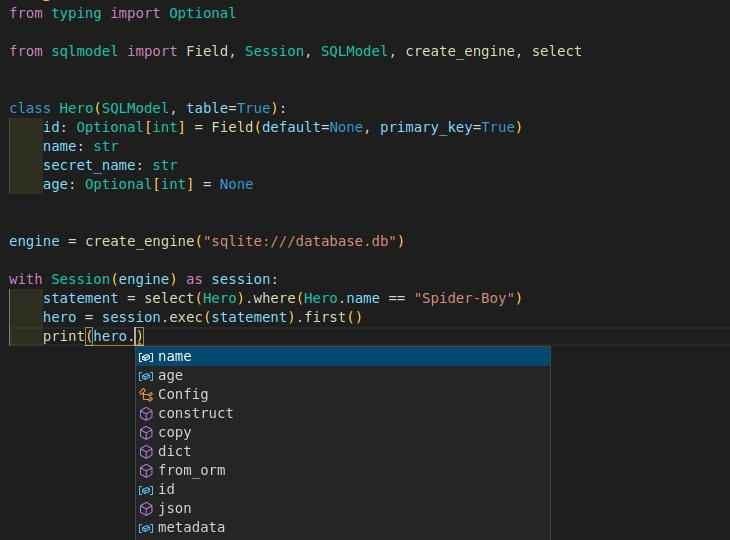
SQLModel, SQL databases in Python, designed for simplicity, compatibility, and robustness.
--- **Documentation**: https://sqlmodel.tiangolo.com **Source Code**: https://github.com/fastapi/sqlmodel --- SQLModel is a library for interacting with SQL databases from Python code, with Python objects. It is designed to be intuitive, easy to use, highly compatible, and robust. **SQLModel** is based on Python type annotations, and powered by Pydantic and SQLAlchemy. The key features are: * **Intuitive to write**: Great editor support. Completion everywhere. Less time debugging. Designed to be easy to use and learn. Less time reading docs. * **Easy to use**: It has sensible defaults and does a lot of work underneath to simplify the code you write. * **Compatible**: It is designed to be compatible with **FastAPI**, Pydantic, and SQLAlchemy. * **Extensible**: You have all the power of SQLAlchemy and Pydantic underneath. * **Short**: Minimize code duplication. A single type annotation does a lot of work. No need to duplicate models in SQLAlchemy and Pydantic. ## Sponsors {% if sponsors %} {% for sponsor in sponsors.gold -%} **SQLModel** is designed to simplify interacting with SQL databases in FastAPI applications, it was created by the same author. 😁
It combines SQLAlchemy and Pydantic and tries to simplify the code you write as much as possible, allowing you to reduce the **code duplication to a minimum**, but while getting the **best developer experience** possible.
**SQLModel** is, in fact, a thin layer on top of **Pydantic** and **SQLAlchemy**, carefully designed to be compatible with both.
## Requirements
A recent and currently supported version of Python.
As **SQLModel** is based on **Pydantic** and **SQLAlchemy**, it requires them. They will be automatically installed when you install SQLModel.
## Installation
Make sure you create a virtual environment, activate it, and then install SQLModel, for example with:
**SQLModel** is designed to simplify interacting with SQL databases in FastAPI applications, it was created by the same author. 😁
It combines SQLAlchemy and Pydantic and tries to simplify the code you write as much as possible, allowing you to reduce the **code duplication to a minimum**, but while getting the **best developer experience** possible.
**SQLModel** is, in fact, a thin layer on top of **Pydantic** and **SQLAlchemy**, carefully designed to be compatible with both.
## Requirements
A recent and currently supported version of Python.
As **SQLModel** is based on **Pydantic** and **SQLAlchemy**, it requires them. They will be automatically installed when you install SQLModel.
## Installation
Make sure you create a virtual environment, activate it, and then install SQLModel, for example with:
 And **inline errors**:
And **inline errors**:
 ### Write to the Database
You can learn a lot more about **SQLModel** by quickly following the **tutorial**, but if you need a taste right now of how to put all that together and save to the database, you can do this:
```Python hl_lines="16 19 21-25"
from sqlmodel import Field, Session, SQLModel, create_engine
class Hero(SQLModel, table=True):
id: int | None = Field(default=None, primary_key=True)
name: str
secret_name: str
age: int | None = None
hero_1 = Hero(name="Deadpond", secret_name="Dive Wilson")
hero_2 = Hero(name="Spider-Boy", secret_name="Pedro Parqueador")
hero_3 = Hero(name="Rusty-Man", secret_name="Tommy Sharp", age=48)
engine = create_engine("sqlite:///database.db")
SQLModel.metadata.create_all(engine)
with Session(engine) as session:
session.add(hero_1)
session.add(hero_2)
session.add(hero_3)
session.commit()
```
That will save a **SQLite** database with the 3 heroes.
### Select from the Database
Then you could write queries to select from that same database, for example with:
```Python hl_lines="13-17"
from sqlmodel import Field, Session, SQLModel, create_engine, select
class Hero(SQLModel, table=True):
id: int | None = Field(default=None, primary_key=True)
name: str
secret_name: str
age: int | None = None
engine = create_engine("sqlite:///database.db")
with Session(engine) as session:
statement = select(Hero).where(Hero.name == "Spider-Boy")
hero = session.exec(statement).first()
print(hero)
```
### Editor Support Everywhere
**SQLModel** was carefully designed to give you the best developer experience and editor support, **even after selecting data** from the database:
### Write to the Database
You can learn a lot more about **SQLModel** by quickly following the **tutorial**, but if you need a taste right now of how to put all that together and save to the database, you can do this:
```Python hl_lines="16 19 21-25"
from sqlmodel import Field, Session, SQLModel, create_engine
class Hero(SQLModel, table=True):
id: int | None = Field(default=None, primary_key=True)
name: str
secret_name: str
age: int | None = None
hero_1 = Hero(name="Deadpond", secret_name="Dive Wilson")
hero_2 = Hero(name="Spider-Boy", secret_name="Pedro Parqueador")
hero_3 = Hero(name="Rusty-Man", secret_name="Tommy Sharp", age=48)
engine = create_engine("sqlite:///database.db")
SQLModel.metadata.create_all(engine)
with Session(engine) as session:
session.add(hero_1)
session.add(hero_2)
session.add(hero_3)
session.commit()
```
That will save a **SQLite** database with the 3 heroes.
### Select from the Database
Then you could write queries to select from that same database, for example with:
```Python hl_lines="13-17"
from sqlmodel import Field, Session, SQLModel, create_engine, select
class Hero(SQLModel, table=True):
id: int | None = Field(default=None, primary_key=True)
name: str
secret_name: str
age: int | None = None
engine = create_engine("sqlite:///database.db")
with Session(engine) as session:
statement = select(Hero).where(Hero.name == "Spider-Boy")
hero = session.exec(statement).first()
print(hero)
```
### Editor Support Everywhere
**SQLModel** was carefully designed to give you the best developer experience and editor support, **even after selecting data** from the database:
 ## SQLAlchemy and Pydantic
That class `Hero` is a **SQLModel** model.
But at the same time, ✨ it is a **SQLAlchemy** model ✨. So, you can combine it and use it with other SQLAlchemy models, or you could easily migrate applications with SQLAlchemy to **SQLModel**.
And at the same time, ✨ it is also a **Pydantic** model ✨. You can use inheritance with it to define all your **data models** while avoiding code duplication. That makes it very easy to use with **FastAPI**.
## License
This project is licensed under the terms of the [MIT license](https://github.com/fastapi/sqlmodel/blob/main/LICENSE).
## SQLAlchemy and Pydantic
That class `Hero` is a **SQLModel** model.
But at the same time, ✨ it is a **SQLAlchemy** model ✨. So, you can combine it and use it with other SQLAlchemy models, or you could easily migrate applications with SQLAlchemy to **SQLModel**.
And at the same time, ✨ it is also a **Pydantic** model ✨. You can use inheritance with it to define all your **data models** while avoiding code duplication. That makes it very easy to use with **FastAPI**.
## License
This project is licensed under the terms of the [MIT license](https://github.com/fastapi/sqlmodel/blob/main/LICENSE).